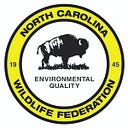Wild Bees of North Carolina: Friends Not Foes
North Carolina has more than 500 native bee species. While this may give some people the willies, wild bees are generally harmless and they offer many benefits to ecosystems, biodiversity and agriculture.
The best way to learn about native bees is by planting a pollinator garden filled with native plants where you can watch them work. Plants in the Asteraceae family, such as asters, goldenrods and coneflowers support the widest variety of native bees. It is ideal to install these beds in lower-traffic areas so you and the bees can stay out of each other’s way.
In addition to providing food, it is important to remember that most bees rely on stems, leaves and soil for nesting material. That’s why avoiding chemical pesticides and herbicides has a huge impact on the overall health and success of bee populations. Adults may only briefly interact with contaminated material, but their offspring could be snuggled up to them for several months.
For help identifying wild bees and how you can support them, watch “Getting to Know Wild Bees in Your Garden,” an online presentation by urban ecologist, Elsa Youngsteadt, hosted by our Concord Wildlife Alliance chapter.
If attracting bees to your yard still worries you, think again. More than half of North Carolina’s native bees are solitary nesters, which makes them far less likely to sting. If bees display aggressive behavior it is often a last resort defense to protect their hives or their lives.
Bees help our gardens thrive and provide essential food resources for wildlife that rely on flowering plants or insects and larvae for survival. While non-native honey bees are great pollinators, bumblebees and other native bees are our most important pollinators.
Many native bees are nesting from March to May in North Carolina. Nest habitat varies depending on the species. The majority of bees will either build their own nests, utilize pre-existing cavities or lay their eggs in the nests of other bees. There are ground nesting bees, such as mining bees, leaf-cutting bees that utilize bits of plant material to line their nests, bees that nest in the pithy interior of stems and countless other configurations.
Native bees, like most wildlife, benefit from non-landscaped natural areas and untidy gardens, where dead stems and materials provide essential nesting materials and habitat. Leaving areas of exposed ground or old stems in the garden can serve as nesting sites for native bees and attract a diversity of pollinators to your area.
If natural landscaping is not an option for you, you can consider an artificial nesting site such as a bee hotel or relocating cut-back stems to create supplementary habitat.
You can buy these or build them by drilling various size holes into untreated wood. In general, bigger is not better for bee hotels. Smaller units dispersed around the yard can reduce predation and disease, and will likely attract more bees. Another option is repurposing hollow stems by stacking them in a quiet corner or weaving them into a “wattle fence” that naturally deteriorates over time. Bee hotels require some routine maintenance that the more natural alternatives do not, such as seasonal cleaning of the nesting holes and replacement after a few years of use.
While most native bees are generalists in their diet, North Carolina has a number of specialists that require specific plants to survive. You can have the greatest impact by adding native plants that support generalists and specialists from the aster (asteraceae), blueberry (ericaceae), willow (salicaceae) or nightshade (solanaceae) families including asters, goldenrod, sunflowers and blueberries.
The presence of cuckoo bees can be a sign that you have a healthy “bee-cosystem” since they rely on other bees to support their young. Instead of provisioning their nests with their own pollen, they will break into the nests of other bees to lay their eggs. This kind of parasitic behavior helps control populations and allows for pollinator diversity.
There are many ways you can help wildlife in your own backyard. We are happy to help you find your niche in creating habitat for pollinators and other wildlife, whether you are just starting out or you are an old hand in the garden who wants to have a greater impact.
Read more about gardening for wildlife at www.ncwf.org and learn more about the impact of habitat loss and how NCWF is joining with volunteers, local wildlife chapters, professionals and communities to conserve habitats statewide through native plantings, trash cleanups and providing resources for communities and residents who want to make a difference for wildlife.
